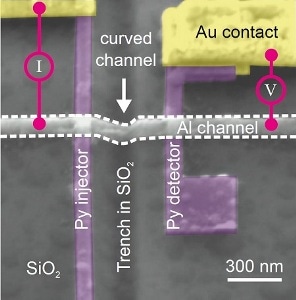Oct 1 2019
3D structures are currently being studied in order to boost the efficiency of microchips. However, spintronic components, which depend on electron spin instead of charge, are constantly flat.
 Scanning electron microscope image of a non-local spin-valve with a curved nano-channel. Transport of pure spin current has been achieved and can be controlled by changing the 3D geometry of the nano-channel. (Illustration Das et al, Nano Letters)
Scanning electron microscope image of a non-local spin-valve with a curved nano-channel. Transport of pure spin current has been achieved and can be controlled by changing the 3D geometry of the nano-channel. (Illustration Das et al, Nano Letters)
To find out ways to link these to 3D electronics, University of Groningen physicist Dr Kumar Sourav Das designed curved spin transport channels.
Along with his colleagues, he found that this new geometry makes it feasible to freely tweak charge and spin currents. The results were reported online by the journal Nano Letters on September 13th, 2019.
Das began with two key questions: how to tweak spin current using geometry, and how to generate spin transport in a 3D nanostructure. Electron spin is a quantum mechanical property, a magnetic moment that can be used to shift or store data. Spin is already used in memory storage, and could also be applied to logic circuits.
Curved Architecture
So far, most spintronic devices have been based on a flat structure. We wanted to find out how the spin currents behave in a curved channel.
Dr Kumar Sourav Das, Physicist, University of Groningen
Using silicon oxide substrates with trenches formed by an ion beam, engineered at the HZDR in Dresden by Dr Denys Makarov, Das grew aluminum nanochannels that crossed the trenches. In this curved architecture, aluminum’s thickness differs at nanoscale dimensions, shorter than the spin relaxation length.
Using different sized trenches, Das measured spin resistance as well as charge currents. “What we discovered is that variations in the trench size affect spin and charge transport in the channel differently,” Das explained. “We were therefore able to independently tune both spin and charge currents based on the channel geometry.”
Functionalities
Dr Carmine Ortix, Das’ colleague from Utrecht University, developed a theoretical model describing this occurrence.
Our theory clearly demonstrates that it is possible to independently tune the spin and charge characteristics using the shape of the materials alone. This possibility overcomes the existing technological hurdles for the applicability of spintronics in modern electronics.
Dr Carmine Ortix, Assistant Professor, Utrecht University
Dr Ortix added, “Extending low-dimensional structures into the three-dimensional space can provide the means to modify conventional functionalities or even launch completely novel functionalities by suitably tailoring the shape of real materials.”
This discovery is important because it allows us to tune spintronic components to match both the spin current and the charge current of electronic circuits. It enables the efficient integration of spin injectors and detectors or spin transistors into modern 3D circuitry.
Dr Kumar Sourav Das, Physicist, University of Groningen
This could help in developing more energy-efficient electronics, as spintronics is a smart way of building low-power devices. “And we can now use our model to purpose-design channels.”
The research was conducted as part of the FET European project “Curved nanomembranes for Topological Quantum Computation.” The experiments were started and overseen by Dr Ivan Vera-Marun at the University of Manchester. Dr Kumar Sourav Das conducted the experiments as a part of his PhD project in the Physics of Nanodevices group led by Prof. Bart van Wees.
This group is part of the Zernike Institute for Advanced Materials at the University of Groningen. The theoretical model was developed by Dr Carmine Ortix at Utrecht University and colleagues from Italy.
Revolutie in micro-elektronica door spinnende elektronen
Video presenting the basics of spintronics. (Video credit: University of Groningen)